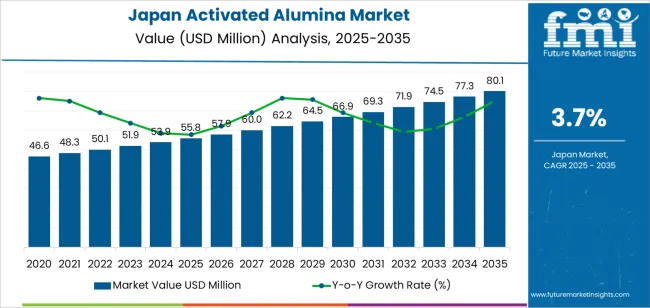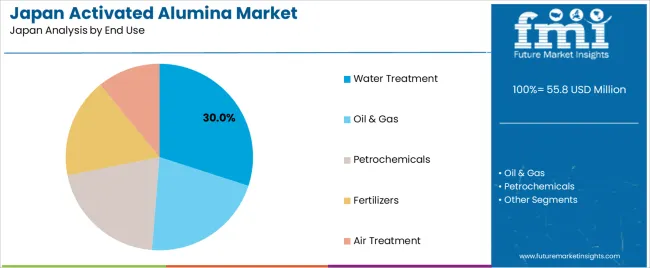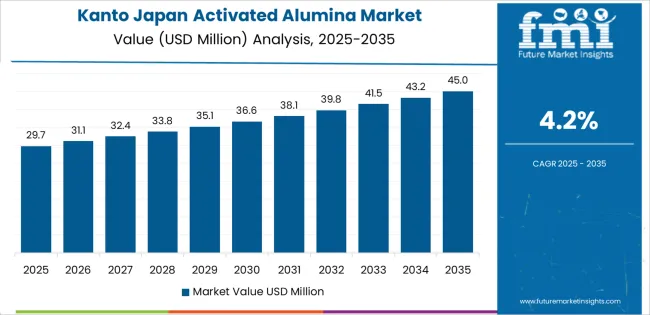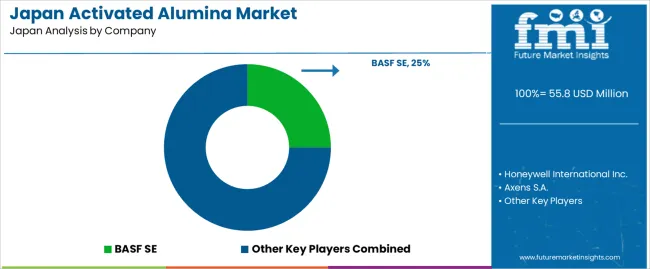The demand for activated alumina in Japan is expected to grow from USD 55.8 million in 2025 to USD 80.1 million by 2035, reflecting a CAGR of 3.7%. Activated alumina is a versatile material used primarily in air drying, water purification, and industrial desiccant applications. The demand for activated alumina is driven by increasing requirements for filtration systems, environmental control, and high-performance adsorbent materials in industries such as oil and gas, pharmaceuticals, automotive, and chemical manufacturing. As Japan continues to prioritize sustainability, energy efficiency, and environmental protection, the demand for activated alumina in these sectors is expected to remain strong. Additionally, the material’s growing use in water treatment and desulfurization processes will contribute to consistent market growth.
The expansion of renewable energy and eco-friendly technologies will also enhance demand for activated alumina as industries increasingly turn to sustainable materials. With continuous technological innovations in activated alumina applications, especially in the electronics and chemical industries, the market is expected to show steady growth. Improvements in adsorption capacity and efficiency will further reinforce its demand across various industrial processes, providing significant growth opportunities through 2035.

The Contribution of Volume vs Price Growth Analysis for activated alumina in Japan reveals how the market expansion will be driven by both increased volume and rising prices over the forecast period from 2025 to 2035.
Between 2025 and 2030, the market will grow from USD 55.8 million to USD 66.9 million, adding USD 11.1 million in value. The primary driver during this period will be volume growth, as the demand for activated alumina increases due to its expanding use in water treatment, air purification, and industrial filtration systems. The need for higher adsorption capacities and improved purification systems in key sectors will push up volume demand. At the same time, slight price increases due to raw material costs and manufacturing improvements will contribute to overall revenue growth.
From 2030 to 2035, the market will grow from USD 66.9 million to USD 80.1 million, adding USD 13.2 million in value. This phase will see a greater contribution from price growth, driven by advancements in activated alumina technology that enhance its performance and efficiency. As industries demand higher quality materials, the prices of activated alumina will likely increase, particularly in specialized applications such as desulfurization and high-end filtration systems. While volume growth will continue to be a key driver, price increases driven by technological advancements, supply chain dynamics, and raw material pricing will account for a larger share of market expansion during this later phase. Thus, the contribution from price growth will become more significant in the latter half of the forecast period as the market for activated alumina matures and adopts more efficient and specialized products.
| Metric | Value |
|---|---|
| Sales Value (2025) | USD 55.8 million |
| Forecast Value (2035) | USD 80.1 million |
| Forecast CAGR (2025-2035) | 3.7% |
Demand for activated alumina in Japan is steady and somewhat conservative, growing at a moderate compound annual growth rate (CAGR) of around 3.7 %. The material is mainly used in high purity applications such as electronics manufacturing, pharmaceuticals, and gas drying where Japanese industry places high value on reliability and precision. Because Japan lacks abundant raw resources for this material, it relies significantly on imports and high quality domestic production to meet these specialty needs.
Several factors support this demand. First, Japan’s advanced manufacturing sectors—including semiconductor fabrication and pharmaceutical production—require adsorbents and desiccants with very low impurity levels, for which activated alumina is suited. Second, regulatory and environmental drivers in sectors such as water treatment and gas purification contribute to its use, although growth in those areas is slower relative to emerging markets. Challenges include higher cost of specialty grades, limited domestic supply capacity, and competition from alternative adsorbents like zeolites or silica gels. Nonetheless, the focus on quality driven applications ensures that Japan remains a consistent market for activated alumina.
The demand for activated alumina in Japan is driven by two key factors: particle size and end use. The leading particle size is 0.5-2 mm, holding 35% of the market share, while water treatment is the dominant end-use sector, accounting for 30% of the demand. Activated alumina is widely used in industries requiring high adsorption capacities for removing impurities, particularly in water purification, oil and gas processing, and air treatment. As regulations around water quality and environmental standards continue to tighten, the demand for activated alumina in these applications remains robust.

The 0.5-2 mm particle size leads the activated alumina market in Japan, capturing 35% of the demand. This particle size is preferred due to its excellent balance of surface area and permeability, making it highly effective in applications that require high adsorption capacity. In water treatment, the 0.5-2 mm particle size is particularly useful for the removal of fluoride, arsenic, and other heavy metals from drinking water. It also serves in air treatment applications, where it helps in removing moisture and contaminants from gases.
The 0.5-2 mm activated alumina is also commonly used in industrial processes for its ability to absorb impurities, stabilize chemicals, and enhance product quality. Its versatility in water purification and environmental treatment applications has made it the preferred choice across various industries in Japan. As the demand for clean water and air increases, driven by environmental concerns and stricter regulations, the 0.5-2 mm particle size is expected to maintain its leadership in the activated alumina market in Japan.

Water treatment is the leading end-use sector for activated alumina in Japan, accounting for 30% of the market share. Activated alumina plays a critical role in water purification by removing contaminants like fluoride, arsenic, and other heavy metals that pose risks to human health. It is particularly effective in drinking water treatment and wastewater filtration, where it helps ensure water quality meets regulatory standards and is safe for consumption.
The growing concern over water quality and increasing government regulations around water safety continue to drive the demand for activated alumina in Japan. The country's commitment to environmental sustainability and public health ensures that the need for advanced water treatment solutions remains high. Activated alumina’s ability to efficiently remove harmful substances and its longevity in filtration systems make it a preferred choice in water treatment. As water quality standards continue to evolve, the demand for activated alumina in water treatment applications is expected to remain strong, reinforcing its position as the dominant end-use sector in Japan.
Demand for activated alumina in Japan is shaped by its critical role in applications requiring high purity adsorbents, such as semiconductor manufacturing, compressed air drying, gas purification and specialty water treatment. Japanese industries place a premium on quality, reliability and regulatory compliance, which supports a market structure focused on performance grades and niche consumption rather than high volume commodity use. At the same time, slow growth in traditional heavy industries and high-cost manufacturing conditions temper rapid expansion.
What Are The Primary Growth Drivers For Activated Alumina Demand in Japan?
Several factors support demand growth in Japan. First, the country’s advanced electronics and semiconductor sector requires ultra dry gas, moisture control and adsorption solutions in clean room environments, driving uptake of high grade activated alumina. Second, increasingly stringent environmental and water quality standards promote use of adsorbents such as activated alumina in selective contaminant removal (e.g., fluoride, arsenic) and industrial water treatment systems. Third, hydrogen production, fuel cell deployment and high purity gas applications are emerging in Japan, creating new use cases for activated alumina in gas drying and purification roles. Fourth, the premiumisation of process gas and chemical infrastructure means firms are willing to pay for tailored adsorbents with longer service life and reliable performance.
What Are The Key Restraints Affecting Activated Alumina Demand in Japan?
Despite supportive factors, there are restraints on demand. Japan’s overall industrial growth is modest compared with emerging economies, limiting incremental volume growth for bulk adsorbents. High manufacturing and raw material costs (such as alumina, energy, logistics) reduce the cost competitiveness of domestic activated alumina production. Alternative adsorbents or materials (molecular sieves, silica gels, polymer based desiccants) may substitute where ultra high performance is not required, constraining demand for high cost activated alumina grades. In addition, recycling and regeneration of spent adsorbents are less developed, leading to higher total cost of ownership for users and limiting uptake in cost sensitive applications.
What Are The Key Trends Shaping Activated Alumina Demand in Japan?
Trends in Japan include a migration toward ultra fine and specialty grade activated alumina with tailored pore sizes, treated surfaces and extended service life for precision industrial applications. Another trend is the integration of activated alumina into hydrogen economy value chains, where gas drying, hydrogen purification and fuel cell applications drive technical requirements. Sustainable and circular economy considerations are leading to adsorbent regeneration services, longer life media and localisation of supply to reduce shipping carbon footprints. Finally, suppliers and end users in Japan are collaborating to develop adsorbent solutions adapted to niche sectors—such as semiconductor fabrication, high purity compressed air, and clean hydrogen infrastructure—rather than broad based commodity use.
The demand for activated alumina in Japan is increasing as the material is widely used in applications such as water treatment, air purification, catalyst supports, and desiccants in industries like chemicals, pharmaceuticals, and automotive. Activated alumina is valued for its high surface area, adsorption capabilities, and ability to remove impurities and moisture from liquids and gases. As Japan continues to focus on environmental sustainability, pollution control, and the development of cleaner technologies, the demand for activated alumina is expected to grow. Regional demand varies based on industrial activity, population density, and local environmental needs. Kyushu & Okinawa leads in demand due to strong industrial activities and environmental applications, followed by Kanto and Kinki, which have significant manufacturing and technological sectors. This analysis explores the factors driving the demand for activated alumina across different regions in Japan.
| Region | CAGR (205-2035) |
|---|---|
| Kyushu & Okinawa | 4.6% |
| Kanto | 4.2% |
| Kinki | 3.7% |
| Chubu | 3.3% |
| Tohoku | 2.9% |
| Rest of Japan | 2.7% |
Kyushu & Okinawa leads Japan in the demand for activated alumina with a CAGR of 4.6%. The region’s strong industrial base, particularly in sectors like petrochemicals, water treatment, and air purification, is a key driver for this demand. Kyushu & Okinawa’s focus on environmental protection and pollution control further fuels the need for activated alumina, especially for water and wastewater treatment, which is a significant application in the region.
The region is also home to various manufacturing plants that use activated alumina as a desiccant or catalyst support, which is essential in processes such as gas drying, chemical production, and refining. As Japan continues to focus on environmental sustainability, particularly in water treatment and air quality improvement, Kyushu & Okinawa will maintain strong demand for activated alumina.

The Kanto region shows strong demand for activated alumina with a CAGR of 4.2%. Kanto, home to Tokyo and the surrounding urban areas, is a major center for industrial activities, including chemical production, pharmaceuticals, and electronics manufacturing. These sectors often rely on activated alumina in water purification, air filtration, and as a catalyst support in various chemical processes.
The region's high population density and significant focus on improving air and water quality also drive demand for activated alumina in environmental applications. Furthermore, Kanto’s strong infrastructure for research and development in sustainable technologies contributes to continued demand for activated alumina in advanced purification and filtration systems. As Kanto continues to lead in industrial innovation and environmental sustainability, demand for activated alumina will remain robust.
The Kinki region demonstrates steady demand for activated alumina with a CAGR of 3.7%. Kinki, which includes Osaka and Kyoto, has a diverse industrial base, including chemical manufacturing, pharmaceutical production, and electronics. These industries contribute to consistent demand for activated alumina for use in desiccants, catalysts, and purification processes.
Additionally, Kinki's focus on sustainability and green manufacturing practices supports the growing need for activated alumina, particularly in air and water filtration applications. As the region continues to innovate in industrial and environmental technologies, the demand for activated alumina will grow steadily, driven by both industrial needs and environmental regulations.
The Chubu region shows a moderate CAGR of 3.3%. Chubu, home to industrial hubs like Nagoya, has a strong manufacturing sector, particularly in automotive, electronics, and chemicals, all of which contribute to demand for activated alumina. Activated alumina is used extensively in catalyst support applications, particularly in the chemical and petrochemical industries, which are prevalent in Chubu.
In addition to industrial demand, Chubu’s focus on environmental protection, particularly in water treatment and air purification, further drives the adoption of activated alumina. While demand in Chubu is slower compared to Kyushu & Okinawa and Kanto, the region’s industrial base ensures steady use of activated alumina in various sectors.
Tohoku shows a CAGR of 2.9%, while the Rest of Japan follows with 2.7%. These regions experience slower growth in activated alumina demand compared to other areas like Kyushu & Okinawa and Kanto. Tohoku, being more rural and less industrialized than other regions, has less intensive demand for activated alumina in large-scale industrial applications. However, there is still steady use in water treatment and air purification, particularly in smaller, local-scale projects.
The Rest of Japan, which encompasses more geographically diverse areas, also experiences slower growth, but there is consistent demand due to agricultural applications, localized water purification needs, and increasing adoption of sustainable technologies in both industrial and residential sectors. While growth is slower, the continued emphasis on environmental protection and improving water quality in these regions ensures steady demand for activated alumina.

Demand for activated alumina in Japan is growing due to its widespread use in applications such as water treatment, air purification, and catalytic processes in industries including petrochemicals, pharmaceuticals, and chemicals. Companies like BASF SE (holding approximately 25% market share), Honeywell International Inc., Axens S.A., Sumitomo Chemical Co., Ltd., and Porocel Industries LLC (Evonik) are key players in this market. Activated alumina's ability to remove contaminants like fluoride, arsenic, and sulfur makes it essential in both environmental and industrial processes, driving its demand in Japan, where strict environmental standards and technological advancements in industries contribute to its steady adoption.
Competition in the activated alumina market is largely driven by material quality, product performance, and the ability to meet diverse application needs. Companies are focused on enhancing the adsorptive capacity and regeneration properties of activated alumina to improve efficiency in water filtration and air treatment. Additionally, there is a growing emphasis on sustainability, with manufacturers promoting eco-friendly production methods and high-recycling content in their activated alumina products. Another strategy is expanding product lines to cater to specific industry requirements, such as customized pore size distribution and enhanced chemical stability for various processes. Marketing materials typically highlight features such as surface area, pore volume, moisture content, and specific use cases like industrial gas purification, water deionization, and catalyst support. By aligning their products with the increasing demand for effective and sustainable filtration solutions, these companies aim to maintain and grow their share in the Japanese activated alumina market.
| Items | Details |
|---|---|
| Quantitative Units | USD Million |
| Regions Covered | Japan |
| Particle Size | Powder, 0.5-2 mm, 2-5 mm, 5-10 mm |
| End Use | Water Treatment, Oil & Gas, Petrochemicals, Fertilizers, Air Treatment |
| Key Companies Profiled | BASF SE, Honeywell International Inc., Axens S.A., Sumitomo Chemical Co., Ltd., Porocel Industries LLC (Evonik) |
| Additional Attributes | The market analysis includes dollar sales by particle size and end-use categories. It also covers regional demand trends in Japan, particularly in water treatment, oil & gas, and petrochemical sectors. The competitive landscape highlights major players in the activated alumina market, focusing on innovations in particle size and material efficiency. Trends in the growing demand for activated alumina in air treatment and other industrial applications are explored, along with advancements in activated alumina production and regeneration technologies. |
The global demand for activated alumina in Japan is estimated to be valued at USD 55.8 million in 2025.
The demand for activated alumina in Japan is projected to reach USD 80.1 million by 2035.
The demand for activated alumina in Japan is expected to grow at a 3.7% CAGR between 2025 and 2035.
The key product types are 0.5-2 mm, powder, 2-5 mm and 5-10 mm.
In terms of end use, water treatment segment to command 30.0% share in Japan in 2025.






Our Research Products

The "Full Research Suite" delivers actionable market intel, deep dives on markets or technologies, so clients act faster, cut risk, and unlock growth.

The Leaderboard benchmarks and ranks top vendors, classifying them as Established Leaders, Leading Challengers, or Disruptors & Challengers.

Locates where complements amplify value and substitutes erode it, forecasting net impact by horizon

We deliver granular, decision-grade intel: market sizing, 5-year forecasts, pricing, adoption, usage, revenue, and operational KPIs—plus competitor tracking, regulation, and value chains—across 60 countries broadly.

Spot the shifts before they hit your P&L. We track inflection points, adoption curves, pricing moves, and ecosystem plays to show where demand is heading, why it is changing, and what to do next across high-growth markets and disruptive tech

Real-time reads of user behavior. We track shifting priorities, perceptions of today’s and next-gen services, and provider experience, then pace how fast tech moves from trial to adoption, blending buyer, consumer, and channel inputs with social signals (#WhySwitch, #UX).

Partner with our analyst team to build a custom report designed around your business priorities. From analysing market trends to assessing competitors or crafting bespoke datasets, we tailor insights to your needs.
Supplier Intelligence
Discovery & Profiling
Capacity & Footprint
Performance & Risk
Compliance & Governance
Commercial Readiness
Who Supplies Whom
Scorecards & Shortlists
Playbooks & Docs
Category Intelligence
Definition & Scope
Demand & Use Cases
Cost Drivers
Market Structure
Supply Chain Map
Trade & Policy
Operating Norms
Deliverables
Buyer Intelligence
Account Basics
Spend & Scope
Procurement Model
Vendor Requirements
Terms & Policies
Entry Strategy
Pain Points & Triggers
Outputs
Pricing Analysis
Benchmarks
Trends
Should-Cost
Indexation
Landed Cost
Commercial Terms
Deliverables
Brand Analysis
Positioning & Value Prop
Share & Presence
Customer Evidence
Go-to-Market
Digital & Reputation
Compliance & Trust
KPIs & Gaps
Outputs
Full Research Suite comprises of:
Market outlook & trends analysis
Interviews & case studies
Strategic recommendations
Vendor profiles & capabilities analysis
5-year forecasts
8 regions and 60+ country-level data splits
Market segment data splits
12 months of continuous data updates
DELIVERED AS:
PDF EXCEL ONLINE
Demand Signal Repository Solutions Market Size and Share Forecast Outlook 2025 to 2035
Demand Side Management Market Size and Share Forecast Outlook 2025 to 2035
Demand Response Market Analysis - Size, Share, and Forecast Outlook 2025 to 2035
North America Shipping Supplies Market Trends – Innovations & Growth 2024-2034
Demand of Kozani Saffron in Greece Analysis - Size, Share & Forecast 2025 to 2035
Demand of No-acid Whey Strained Dairy Processing Concepts in European Union Size and Share Forecast Outlook 2025 to 2035
Demand for Bronte Pistachio in Italy Analysis - Size, Share & Forecast 2025 to 2035
Demand and Trend Analysis of Gaming Monitor in Western Europe Size and Share Forecast Outlook 2025 to 2035
Demand and Trend Analysis of Gaming Monitor in Korea Size and Share Forecast Outlook 2025 to 2035
Demand and Trend Analysis of Gaming Monitor in Japan Size and Share Forecast Outlook 2025 to 2035
Glycine Soja (Soybean) Seed Extract Market Size and Share Forecast Outlook 2025 to 2035
Demand and Trend Analysis of Yeast in Japan - Size, Share, and Forecast Outlook 2025 to 2035
Demand of Pistachio-based desserts & ingredients in France Analysis - Size, Share & Forecast 2025 to 2035
Western Europe Men’s Skincare Market Analysis – Forecast 2023-2033
Demand and Trends Analysis of Stevia in Japan Size and Share Forecast Outlook 2025 to 2035
Japan Women’s Intimate Care Market Trends – Growth & Forecast 2024-2034
Demand and Trend Analysis of Fabric Stain Remover in Korea Size and Share Forecast Outlook 2025 to 2035
Demand and Sales Analysis of Paper Cup in Korea Size and Share Forecast Outlook 2025 to 2035
Demand and Sales Analysis of Paper Cup in Western Europe Size and Share Forecast Outlook 2025 to 2035
Demand of MFGM-enriched Powders & RTDs in European Union Size and Share Forecast Outlook 2025 to 2035

Thank you!
You will receive an email from our Business Development Manager. Please be sure to check your SPAM/JUNK folder too.
Chat With
MaRIA